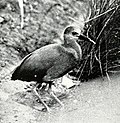| Rallus | |
|---|---|
 | |
| Water rail Rallus aquaticus | |
| Scientific classification | |
| Kingdom: | Animalia |
| Phylum: | Chordata |
| Class: | Aves |
| Order: | Gruiformes |
| Family: | Rallidae |
| Genus: | Rallus Linnaeus, 1758 |
| Type species | |
| Rallus aquaticus [1] Linnaeus, 1758 | |
| Species | |
See list | |
| Synonyms | |
Epirallus Miller, 1942 | |

Rallus is a genus of wetland birds of the rail family. Sometimes, the genera Lewinia and Gallirallus are included in it. Six of the species are found in the Americas, and the three species found in Eurasia, Africa and Madagascar are very closely related to each other, suggesting they are descended from a single invasion of a New World ancestor. [2]
Contents
These are slim, long-billed rails with slender legs. Their laterally flattened bodies are an adaptation to life in wet reedbeds and marshes, enabling them to slip easily through the dense semi-aquatic vegetation. Typically these birds have streaked brown upperparts, blue-grey on the face or breast, and barred flanks. Only the African rail has a plain back, and the plain-flanked rail lacks any blue-grey in its plumage and has no flank bars. [2]
Three endemic South American species are endangered by habitat loss, and the Madagascar rail is becoming rare.












